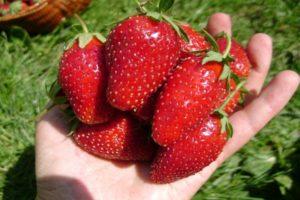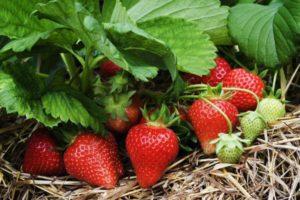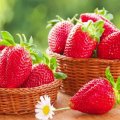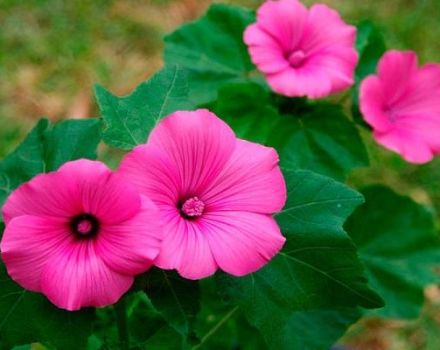Description and characteristics of the Tsaritsa strawberry variety, cultivation and care
For cultivation in central Russia, special varieties of strawberries are being bred. They tolerate cold winters well and bear fruit in any conditions. Among these varieties, the Tsaritsa garden strawberry, obtained by Russian breeders, is distinguished.
Content
- 1 Description and characteristics of the strawberry Queen
- 2 Region of natural growth
- 3 Advantages and disadvantages
- 4 The nuances of growing varieties in the garden
- 5 How to properly care for the Tsaritsa variety
- 6 How to prepare strawberries for winter
- 7 Strawberry propagation
- 8 Disease and pest control
- 9 Harvesting
Description and characteristics of the strawberry Queen
A strawberry variety was obtained by crossing Venta and Red Gotlent. A group led by Professor S. Aidzhanova worked on the development of the hybrid. The plant took the best qualities from its parents, associated with:
- resistance to drought and low temperatures;
- strong immunity against infections;
- excellent berry taste.
The strawberry variety is appreciated for its unpretentious care. But in order to increase berry yields, you need to care for the strawberries correctly.
Bushes
The plant has small compact bushes 20 centimeters high. Medium-sized leaves have a smooth, shiny surface. Their color is dark green. Antennae on the shoots are dark red with slight pubescence.
Flowers and berries
Strawberry Tsaritsa blooms in June. Bushes are covered with white petals. The flowers reach 3-5 centimeters in diameter. Bisexual flowers do not require pollination. The fruit is characterized by a conical shape. From above, the berries are smooth with dense pulp of a rich red color. Their weight reaches 40-50 grams with good care and favorable weather. But over time, the fruits begin to shrink when they barely reach 15 grams.
The Tsarina is distinguished by an excellent sweet taste of false berries with a slight sourness and a unique aroma. Berries are also suitable for fresh consumption, and for making jam, jam.
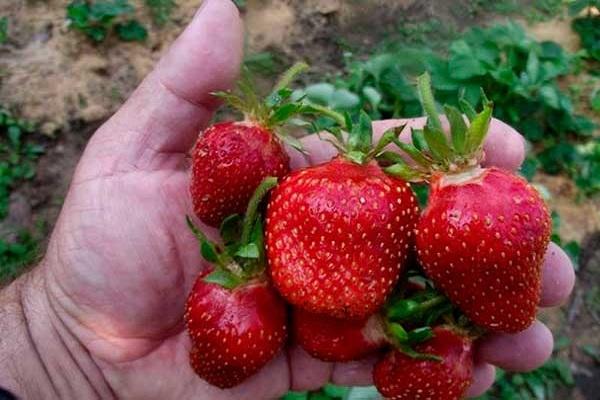
Yield
Fruits on the bushes of the hybrid are formed a little, but they are large. From 1 plant in a good year, you can collect up to 600-700 grams of berries. Yields are lower if summers are cold and rainy.
The vegetation of the crop, its yield depend on the observance of the plant's agricultural technology.
Transportability
Dense berries of the variety are appreciated for the fact that they are stored for a long time. The crop can be transported over long distances, and it will not wrinkle. Therefore, strawberries are chosen for growing on an industrial scale. Moreover, the berries appear at the end of June - July, when the main varieties of the crop have already borne fruit.

Region of natural growth
The Queen owes her qualities to breeders.Since the variety was bred in the Bryansk region, it is zoned in various regions. It bears fruit well in the middle lane, in Siberian and Ural gardens. In the southern regions, it is also not ignored.
If you cover the bushes for the winter, they can easily withstand 40 degrees of frost. In the steppe, the plant endures drought and heat.
Advantages and disadvantages
The advantage of choosing this strawberry variety is its ability to:
- bear fruit amicably within 15 days;
- well tolerate transportation;
- not be damaged by frost, heat;
- be resistant to pathogenic microorganisms;
- bear fruit in one place for 4-6 years.
The disadvantages of the hybrid include its average yield. To increase it, you have to plant more plants.
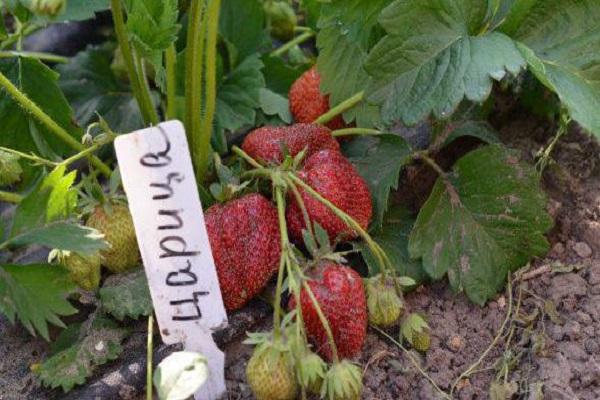
The nuances of growing varieties in the garden
It is not difficult to grow Tsaritsa garden strawberries in the country. Planting and care requirements are not much different from the usual rules of crop farming.
Preparation of planting material
Healthy seedlings play an important role in the development of strawberries in the future. It is necessary to choose seedlings with a strong root system. In this case, the length of the roots should be within 7-10 centimeters. The number of leaves on the stems is 3-4 green, shiny.
It is preferable to purchase seedlings with a closed root system. They quickly adapt to new conditions.
What should be the soil
Strawberries have an increased demand for soil and its nutritional value. Therefore, before planting, it is necessary to increase the fertility of the soil by introducing semi-rotted manure (5-7 kilograms) or chicken droppings (1-2 kilograms) per 1 square meter. A replacement can be a mixture of 2-3 kilograms of humus and 30-50 grams of superphosphate. Plowing of the site is carried out in advance: either in the fall or in early spring.

How to plant correctly
The planting scheme of the Tsaritsa variety requires a distance between seedlings of 30-40 centimeters. The rows are separated from each other by 70-80. It is best to use the cord by pulling it between the pegs to keep the rows straight.
Plant holes are made 7-10 centimeters deep. It is necessary to straighten the roots by placing them in the pits. Sprinkle the seedlings with earth, holding them with one hand. It is important to ensure that the growth point is at ground level.
The seedling is planted correctly, if it passes the test: pull the leaf, it will come off, and the plant will remain in place.
After planting, the seedlings are watered and shaded with a layer of straw and hay.
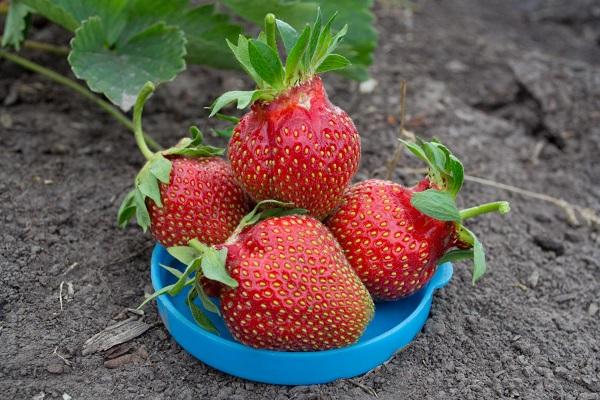
How to properly care for the Tsaritsa variety
In the first year after planting, strawberry bushes are carefully looked after. Watering, feeding, sheltering for the winter. Then the agricultural technology changes a little. After 4-5 years, it is necessary to change the plot for garden strawberries.
How to water and feed
Plants, after being planted, are moistened up to 5 times per summer. A square meter of plantation requires 20-30 liters of water. In winter, they try to take measures to stop the snow in the strawberry garden. Snow falling on thawed ground is compacted.
In the 2nd year, the bushes are watered more abundantly and more often, up to 8 times. It is better to water before the flowering of the plant, during the period of pouring the berries and after picking them. It is necessary to soak the ground well to a depth of 10 centimeters.
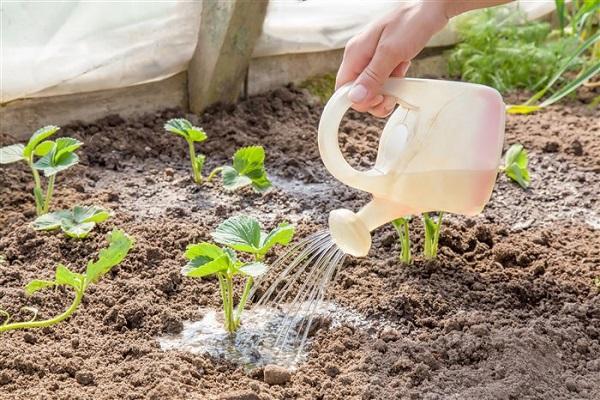
For the first time, plantings are fertilized with ammonium nitrate, superphosphate. As the flower buds appear, you need to water the bushes with a mullein at the rate of 1 part of manure to 6 parts of water.
After the fruits are harvested, the culture is fed with mineral complexes. So they ensure the laying of flower buds next year.
In the third year of the plantation's life, it is necessary to additionally add 2 kilograms of humus per square meter of the garden. In this case, the fertilizer is covered with a shovel to a depth of 6-8 centimeters.

Weeding and loosening the soil
It is imperative to loosen the soil in the garden after each watering.If it rains, then the procedure is also carried out regularly. Weed the plantation as weeds appear. Along with these procedures, the mustache is removed. Leave only a part for breeding.
To increase plant nutrition, after picking the berries, the bushes are hilled.
Mulching
After watering the newly planted bushes, the soil between the rows is mulched. To do this, lay a layer of 6-8 centimeters of sawdust, needles, straw. Leave the tire on for the whole summer. It is harvested after harvest, embedding in the aisles.
If mulching was not carried out in the spring, then a layer of straw and sawdust is placed under the bushes before the berries ripen. This will preserve moisture and protect the crop from damping.
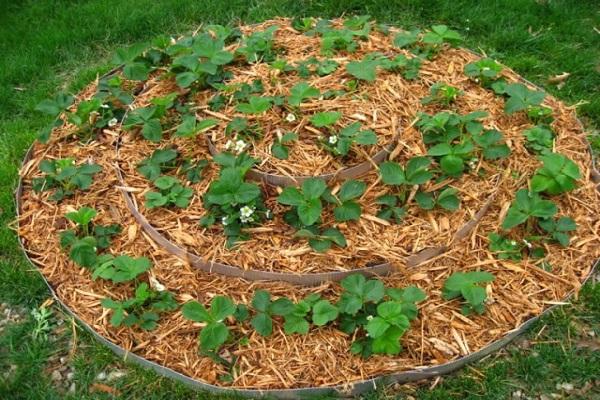
How to prepare strawberries for winter
In November, strawberries are prepared for wintering:
- watering;
- hilling bushes;
- laying on top of spruce branches or last year's foliage, brushwood.
Do not cover plants until the soil is frozen. Otherwise, the berry culture will begin to get wet under cover, rot.
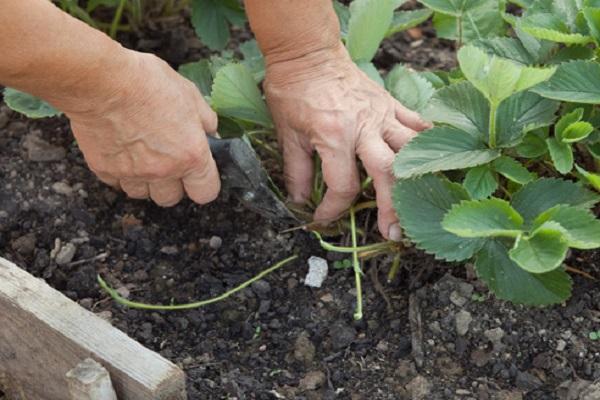
Strawberry propagation
To grow Queen's strawberries from seeds, you need to purchase high-quality ones in a specialized store. They are planted first for seedlings. This requires a container with nutrient soil. The seeds are laid out on the surface, pressing slightly into the moist soil. Then cover the boxes with foil, leaving them in a warm place. Seedlings will not appear soon. But they immediately remove the shelter and put it in a place lit by the sun. During the growth of seedlings, they are watered, the soil is loosened. They are planted when the roots get stronger, and 4 real leaves appear on the stems.
It is easier to propagate strawberries with a mustache. As soon as a socket is formed on them, it is pressed to the ground. Then they sprinkle with earth, watered. After rooting, you can transplant the bush to a new place, separating it from the mother plant.
Many people use reproduction by dividing the bush. The main thing is not to damage the part separated by the knife. She should have a bud of growth and roots 5-7 centimeters long.
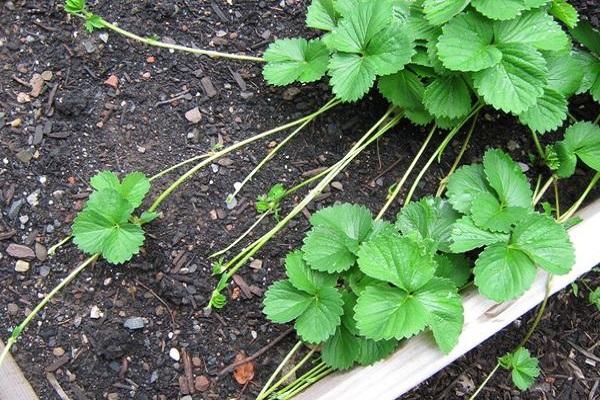
Disease and pest control
The Tsaritsa variety rarely gets sick with infections. If pathogenic fungi appear on the leaves, then they can be destroyed with fungicidal preparations. Treatment with a solution of Bordeaux liquid will also help.
Of the pests, the berries are often damaged by the larvae of the May beetle, wireworm. If you spill the soil well with a solution of ammonia, it will scare away insects.
As a deterrent, you can plant a lupine bed next to it. If a transparent mite or aphid damages the plants, then it is necessary to spray the bushes with "Karbofos".

Harvesting
The berries are harvested in July. It is necessary to tear off the fruits with a stalk. The harvest is put in baskets with a volume of 2-3 kilograms. It is not recommended to pour the berries, as it will wrinkle. Strawberries are kept fresh for 1-2 days. The fruits are processed a few hours after the harvest.
